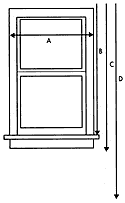|

Pinch-Pleated Draperies: Pleats build fullness into a window treatment, creating a more formal look. Pleated draperies can also be layered over sheer and lace panels. They are usually hung on a traverse rod, to open and close easily.
Rod-Pocket Panels or Curtains: Simply thread the panel over your rod through the pocket sewn at the top, then gather the fabric to make these panels as full as you’d like.
Tab-Top Panels: Designed to go on a decorative rod (since some of it will show through).
Scarves: A long piece of fabric that tapers at the end, it can be draped through decorative wall sconces or looped over a decorative rod or scarf holders. Scarf valances can also be wrapped around a rod to simply frame a window, or layered over panels.
To get the most accurate results, always use a wood or metal ruler, never a cloth tape.
Measuring for Pinch-Pleated Draperies:
1. Determine your rod width.
Rods can be mounted on the window frame, on either side of the frame, on anyplace on a wall you want to cover. Decide where you’re going to put the brackets, then measure the width of the area between the brackets.
2. Determine your drapery width.
Measure the width of the area you want to cover, then add 12 inches.
 3. Determine the drapery length. 3. Determine the drapery length.
The rod should be positioned at least 4 inches above the window so that the pleats are not seen from the outside. Measure for length from where the top of the rod will be to the desired length. Most common lengths are to the windowsill (see B in diagram), just below the window trim (C), or to the floor (D). For a “puddle” look, order the next longer length than your window-to-floor measurement. Where you place the top of the drapery pin determines where the drapery will fall, so if you’re using a decorative rod or pole with rings, measure from the eye of the hook or ring to the sill, apron, or floor.
If you’re using a standard rod, measure the distance from the top of the rod to where the draperies will hang. If floor length is desired and you have carpeting, subtract 1 inch for clearance.
If you’re using a decorative rod, measure the distance from the bottom of the rod to where the draperies will hang. If floor length is desired and you have carpeting, subtract 1 inch for clearance.
Refer to the diagram for help when measuring for any window treatment:
A = window width (including casing, if any)
B = length to windowsill
C = length to apron
D = length to floor.
Measuring for Rod-Pocket Curtains, Pole-Top Styles, and Top Treatments:
1. Determine the width
Measure the area to be covered. To create the fullness you desire, order 2 to 3 times the rod width for sheer or semi-sheer fabrics, and 1½ to 2 times the rod width if the fabric is opaque.
2. Determine the length.
Measure from where the top of the rod will be to the desired length - windowsill (B), apron (C), or floor (D), then add 1 inch to allow for header.
Allow ½ inch for floor or windowsill clearance.
VALANCES & TOP TREATMENTS
|
Valances and top treatments add drama to any window, whether used alone or layered over panels or blinds. For wider windows, order 2 or more valances, or use an insert valance. The total fabric width of the valance should be about twice the rod width. Some suggestions:
Balloon curtains have rod-pocket tops and are usually for single windows 36–54 inches wide. Buy approximately twice the window width for proper fullness.
Jabots or swag pairs can be hung with an insert valance (festoon, e.g.) on the same rod. When hung with a cascade valance, use a double rod and hang on the outer rod.
Confused by any of the terminology? Then click here for our convenient glossary.
|

























